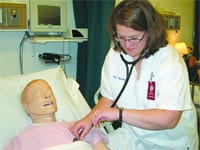The Medical Home An Old Concept Whose Time Has Come
There are two relatively new concepts in health care delivery that are currently in the pilot program stage, but which may dramatically change the way health care providers attend to patient needs. One of these is the accountable care organization (ACO) model (see the May column). The other model is the patient-centered medical home (PCMH).
Both of these are provider-led organizations whose mission is to manage the full continuum of patient care among all providers across the health care system and be accountable for the overall costs and quality of care.
The medical home was first introduced in a 1967 paper published by the American Academy of Pediatrics, which described it as a single center of all medical information concerning a patient. This has evolved to a formal designation by the American Academy of Family Physicians as a patient-centered medical home, or PCMH.
Team Approach
A PCMH is an interactive arrangement between an individual patient and his or her primary-care physician that leads a medical team in coordinating all aspects of well-being throughout a patient’s lifetime. It involves the coordination and continuity of preventive, acute, and chronic needs care across the entire health care spectrum, and the centralization of all data on the patient’s health and treatment. It is widely believed that, through this team approach, coordination of care, and health-record tracking, physicians will be able to improve the quality of care while reducing health care costs by:
- Reduction in duplication of lab and other diagnostic testing;
- Reduction in hospital admissions and readmissions;
- Reduction in emergency-room visits;
- Improving the overall health of individuals through preventive care;
- More effective and cost-efficient care for chronically ill patients; and
- Centralization and sharing of patient medical information among all providers.
This represents a significant change from the current health care delivery system, which is comprised more of episodic treatment patterns with detached services that are paid for based on the volume of procedures and tests rather than the quality of care and outcomes. This fosters an environment in which greater than two-thirds of new physicians choose to pursue higher-paying specialties over primary care, resulting in an alarming shortage of family- and internal-medicine practitioners.
The Centers for Medicare and Medicaid Services (CMS) and some private insurers have already begun testing the concept among physician groups. The National Committee on Quality Assurance has rolled out a program with criteria and standards for recognition as a PCMH.
Practices looking to move toward the PCMH model face certain challenges, which include:
- Costs of staff education and restructuring the practice;
- Investment in, and meaningful use of, electronic health records;
- Recruitment and retention of primary-care physicians;
- Establishing a network team of specialists; and
- Payment reform to adequately compensate physicians.
Of the above challenges, payment reform is likely to be the most critical. Expecting primary-care practices to invest the time and expense to build a PCMH by paying them on a fee-for-service (FFS) basis alone will clearly not be adequate. Compensation for primary-care providers needs to be raised to attract new recruits necessary to make this concept work.
In current pilot projects, CMS and private carriers are supplementing FFS with monthly management fees on a per-capita basis, plus additional pay-for-performance (PFP) incentives. Getting specialists to buy into this will also require some incentives for them because a shift in utilization patterns and a reduction in referrals could have a significant negative impact on their income.
Bottom Line
If the PCMH becomes an integral part of an accountable care organization, a payment structure encompassing some combination of FFS, bundled payment, capitation, and other PFP incentives will likely be shared by all providers.
For more information on pilot projects and organizations helping physicians adapt their practices to the medical home model, visit the Web sites of the National Center for Quality Assurance (www.ncqa.org), the American College of Physicians (www.acoponline.org), and the American Academy of Family Physicians (www.transformed.com).
James B. Calnan, CPA, is partner-in-charge of the Health Care Services Division of Meyers Brothers Kalicka, P.C. in Holyoke.

